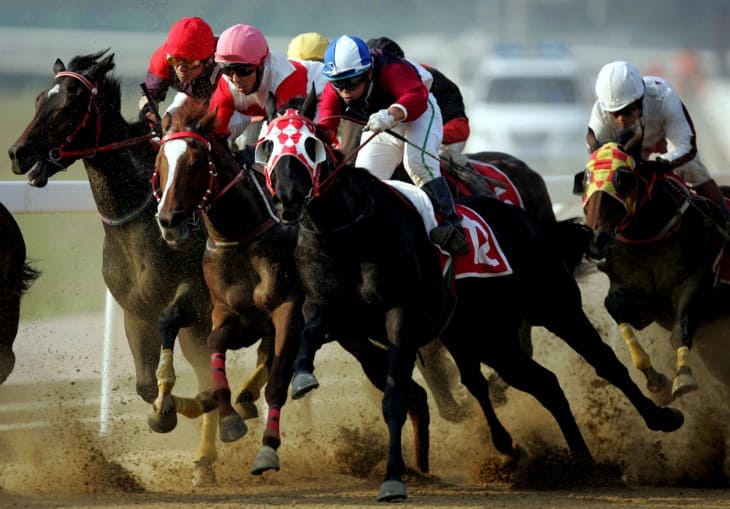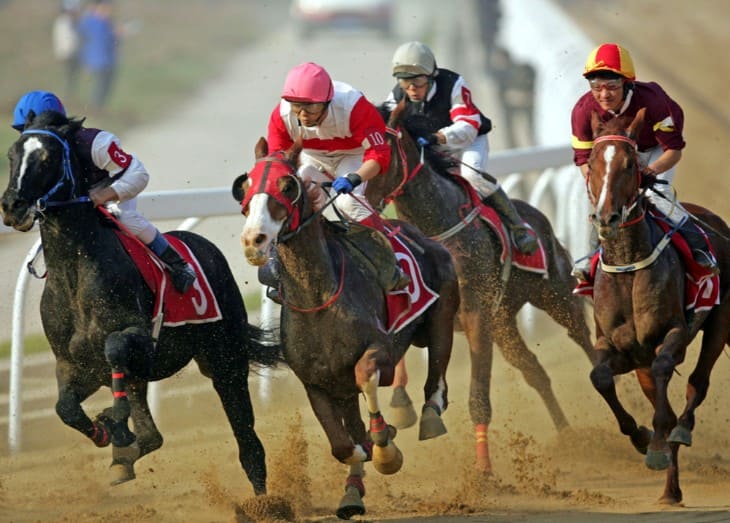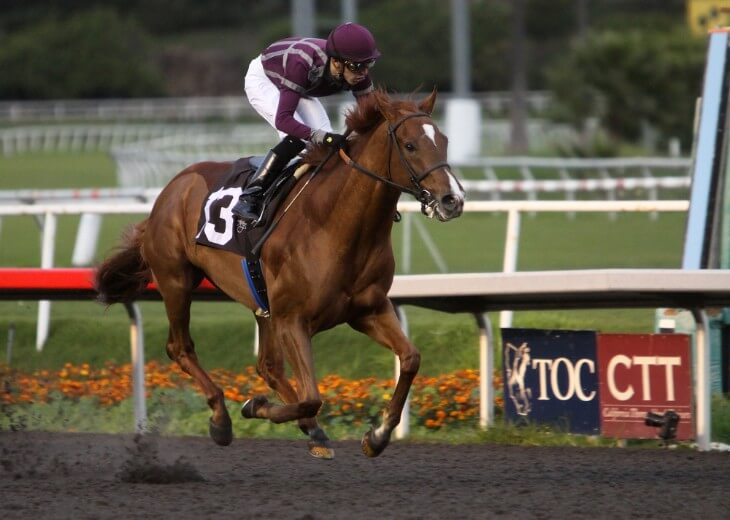- A Closer Look at the Equine Muscular System
- Unravelling the Secrets of Bone Structure in Racehorses
- The Power of Tendons and Ligaments in Speed and Agility
- The Cardiovascular System: Pumping for Victory
- The Role of Breathing and Respiratory Efficiency
- Understanding the Neurological Aspects of Racing Prowess
- Analysing the Ideal Body Proportions of Elite Racehorses
- Spotlight on Common Physical Attributes of Champion Racehorses
- Conclusion
In the exhilarating world of equestrian competitions, the racehorse stands as a true marvel of nature, a living embodiment of speed, power, and endurance. To the casual observer, these majestic creatures may seem like graceful blurs of motion, but beneath their sleek exteriors lies a masterfully engineered anatomical blueprint that propels them to the forefront of racing glory. In this exploration, we shall delve into the intricate inner workings of these remarkable athletes, unravelling the physical attributes that contribute to their unparalleled performance on the racetrack.
A Closer Look at the Equine Muscular System
At the heart of every racehorse's prowess lies its muscular system, a finely tuned network of power and precision. These equine athletes are blessed with an abundance of fast-twitch muscle fibres, which provide them with explosive bursts of speed and acceleration. This unique composition enables them to reach breathtaking velocities, leaving spectators in awe of their lightning-fast sprints.
The muscles of a racehorse are not merely ordinary; they are meticulously sculpted through rigorous training regimes. Their muscle fibres adapt to the demands placed upon them, becoming more efficient and resilient with each stride. This careful balance between power and endurance ensures that racehorses can maintain their blistering pace over long distances, making them the undisputed stars of the racetrack.
Furthermore, the strategic positioning of these muscles plays a pivotal role in the racehorse's agility and flexibility. Their well-developed gluteal and hamstring muscles contribute to their ability to unleash powerful strides, while the muscles around the shoulder and forelimbs facilitate nimble turns during races. It is this intricate interplay of muscle groups that allows racehorses to manoeuver with remarkable dexterity around tight corners and over challenging terrains.
- The fast-twitch muscle fibres in racehorses are optimised for short, intense bursts of power rather than prolonged endurance activities.
- Racehorses undergo specialised training regimens, including high-intensity interval training, to develop and condition their fast-twitch muscle fibres.
- The muscles in a racehorse's hindquarters, such as the gluteal and hamstring muscles, are particularly well-developed, enabling them to generate immense propulsive force during sprinting.
Unravelling the Secrets of Bone Structure in Racehorses
Beneath the rippling muscles lies the foundation of every racehorse's physical prowess – their skeletal structure. Their bones are meticulously designed to withstand the tremendous forces exerted on them during high-speed gallops, jumps, and landings. Long, slender bones in the legs serve to reduce weight without sacrificing strength, enabling them to move with lightning speed while maintaining overall endurance.
One key to the racehorse's success lies in their lightweight yet incredibly sturdy bones. The cannon bones, which form the lower leg, are supported by dense and compact bone tissue, reducing the risk of fractures and injuries that could curtail a promising career. Additionally, the arrangement of bones in the limbs enhances their spring-like action, efficiently converting the energy from muscular contractions into forward motion.
To support their powerful strides, racehorses are equipped with a unique bone structure in their feet as well. Their hooves, comprised of tough yet flexible keratin, provide a combination of shock absorption and traction. This clever adaptation enables them to grip the ground firmly during acceleration and maintain stability during high-speed turns, minimising the risk of slipping or falling.
- Racehorses have a higher ratio of cortical (dense) bone to cancellous (spongy) bone compared to other horses, contributing to their skeletal strength and resilience.
- The cannon bones in a racehorse's lower legs are angled at a specific degree to optimise their spring-like action and propulsion during galloping.
- The unique structure of a racehorse's hooves, with a thick, rounded toe and sloped heels, helps dissipate the immense impact forces experienced during high-speed running.
The Power of Tendons and Ligaments in Speed and Agility
Beyond the muscles and bones, tendons and ligaments play a pivotal role in the racehorse's performance. Tendons are thick, fibrous tissues that connect muscles to bones, acting as powerful elastic bands that store and release energy with each stride. As a racehorse propels forward, its tendons stretch like springs, absorbing and storing potential energy. When the hoof leaves the ground, that stored energy is rapidly released, propelling the horse forward with incredible force.
However, this incredible power comes with the risk of strain and injury. Overexertion or sudden stress on tendons can lead to tears or inflammation, potentially sidelining a racehorse from competition. Owners and trainers meticulously manage their training routines, ensuring a balance between conditioning and rest to keep the tendons strong and resilient.
Ligaments, on the other hand, provide stability to the horse's joints, ensuring smooth and controlled movements during racing. These tough, elastic bands of connective tissue help maintain the integrity of the joints, preventing excessive movement that could result in injury.
- The tendons in a racehorse's lower limbs, particularly the superficial and deep digital flexor tendons, are subject to immense forces during high-speed running and jumping.
- Proper warm-up exercises and gradual training programs help condition and strengthen the tendons and ligaments, reducing the risk of injury.
- Ligaments in the fetlock and knee joints of racehorses play a crucial role in stabilising these high-stress areas during the intense demands of racing.

The Cardiovascular System: Pumping for Victory
The heart of a racehorse is a marvel of efficiency and power. With each gallop, it pumps blood rich in oxygen and nutrients to the muscles, sustaining their demanding efforts. The larger the heart, the greater the volume of blood it can pump, and many champion racehorses possess hearts that are significantly larger than average.
Yet, it's not just the size that matters; it's also the heart's ability to recover quickly between races. A healthy and well-trained racehorse can have a resting heart rate as low as 30 beats per minute, rapidly increasing to over 200 beats per minute during a race. However, within minutes of finishing, their heart rate can drop back to near-resting levels, showcasing their incredible cardiovascular adaptability.
The efficiency of the cardiovascular system is not limited to the heart alone. The respiratory system plays a vital role in delivering oxygen to the muscles during intense exercise. Racehorses have large lungs with a vast surface area for gas exchange, allowing them to take in copious amounts of oxygen with each breath. Their nostrils flare wide open during exertion, facilitating the inflow of oxygen-rich air, and their powerful diaphragm aids in the expulsion of carbon dioxide.
- The size of a racehorse's heart is often used as an indicator of its potential racing performance, with larger hearts being associated with greater endurance and stamina.
- Racehorses have a higher density of capillaries in their muscles compared to other horses, facilitating efficient oxygen and nutrient delivery during intense exercise.
- The cardiovascular system of a racehorse is highly adaptable, allowing for rapid shifts in heart rate and blood flow distribution to meet the demands of racing.
The Role of Breathing and Respiratory Efficiency
In the quest for racing glory, a racehorse's ability to breathe efficiently can make all the difference. The respiratory system is finely tuned to provide a constant and abundant supply of oxygen to the muscles during the intense physical exertion of racing.
One remarkable aspect of racehorses' respiratory system is their nostrils' capacity to flare widely. This ability allows them to draw in vast amounts of oxygen-rich air with each breath, ensuring a continuous supply of the vital gas to power their muscles. Their breathing rate can increase exponentially during a race, reaching up to 150 breaths per minute, which is more than double their resting rate.
Moreover, the anatomy of their respiratory tract contributes to their efficient breathing. The trachea, or windpipe, is wide and well-supported by cartilage rings, preventing collapse during intense exercise. As air travels deeper into the lungs, it passes through smaller tubes called bronchioles, which lead to the alveoli. These tiny air sacs facilitate gas exchange, allowing oxygen to enter the bloodstream and carbon dioxide to be expelled.
- Racehorses have a higher ratio of lung capacity to body weight compared to other horses, allowing for greater oxygen intake during exercise.
- The diaphragm muscle in racehorses is exceptionally strong, enabling powerful inhalations and exhalations during high-intensity racing.
- The efficient respiratory system of racehorses allows them to maintain a high level of aerobic metabolism, which is crucial for sustaining their speed and endurance.
Understanding the Neurological Aspects of Racing Prowess
Beyond the physical attributes, the racehorse's success on the track is also intrinsically linked to its neurological prowess. The nervous system plays a key role in coordinating movements, processing information from the environment, and enabling swift responses to stimuli.
One of the most remarkable neurological features of racehorses is their acute sensory perception. Their large and expressive eyes provide excellent vision, enabling them to swiftly detect obstacles, track competitors, and gauge distances accurately. They are highly attuned to changes in their surroundings, a skill that comes in handy during races with crowded tracks.
Their hearing is equally impressive. Keen ears can pick up subtle cues from their jockeys or the sound of competitors approaching from behind. This heightened auditory awareness helps racehorses react swiftly to their rider's commands and make split-second decisions during races.
- The cerebellum, located at the base of the brain, plays a crucial role in coordinating the intricate movements required for balance and agility during high-speed racing.
- Racehorses have a highly developed vestibular system, which helps maintain their equilibrium and spatial awareness, even during tight turns and sudden changes in direction.
- The bond between a racehorse and its jockey is essential for effective communication and trust, which can significantly impact the horse's performance on the track.

Analysing the Ideal Body Proportions of Elite Racehorses
The anatomy of an elite racehorse extends beyond individual attributes; it also involves the harmonious fusion of various body proportions. Each aspect of their physical structure plays a vital role in determining their performance on the racetrack.
Racehorses are generally long-legged animals, with the length of their limbs contributing to their stride length and overall speed. A longer stride allows them to cover more ground with each step, propelling them forward with greater efficiency. However, there is a delicate balance to be struck, as excessively long limbs can increase the risk of injuries.
Their bodies are well-proportioned, with a relatively short back and a strong, sloping shoulder. This conformation allows for better weight distribution and enables them to maintain balance and stability during high-speed turns. A well-angled shoulder also aids in extending their stride, leading to a more powerful forward motion.
- The ideal body proportions for a racehorse often include a deep chest, which allows for greater lung capacity and improved respiratory efficiency during intense exercise.
- A well-muscled neck and a refined, wedge-shaped head are also desirable traits, contributing to the overall balance and aerodynamics of the racehorse.
- Breeders and trainers carefully evaluate the body proportions of potential racehorses, as even slight deviations from the ideal can significantly impact performance and increase the risk of injury.
Spotlight on Common Physical Attributes of Champion Racehorses
Champion racehorses possess a certain "X-factor" that sets them apart from the rest of the field. While it may be challenging to pinpoint a single defining attribute, there are common physical traits that recur among many victorious racehorses.
One such attribute is the presence of a large heart girth. This measurement, taken around the horse's chest just behind the front legs, reflects the capacity of their heart and lungs. A well-developed heart girth indicates a robust cardiovascular system, capable of delivering oxygen-rich blood to the muscles efficiently. Many renowned racehorses have been celebrated for their exceptional heart girth, which undoubtedly contributes to their outstanding endurance and stamina.
Another common trait found in champion racehorses is the presence of defined withers. The withers are the highest point of the horse's back, located between the shoulder blades. A pronounced withers aids in saddle stability and allows for better weight distribution, essential for maintaining balance during high-speed sprints and turns.
- Champion racehorses often display a sleek, muscular physique, with well-defined muscle groups and a lack of excess fat, which can hinder performance.
- A high-set neck and a well-angled shoulder are also desirable traits, contributing to the horse's ability to extend its stride and generate maximum power.
- While physical attributes are essential, mental toughness and a competitive spirit are also crucial factors that distinguish true champions from the rest of the field.
Conclusion
In the end, the anatomy of a racehorse is a testament to the wonders of evolution and the boundless potential of these incredible creatures. Through their physical attributes and the dedication of those who work with them, they embody the very essence of what it means to be a champion, proving time and again that the pursuit of excellence knows no bounds in the world of horse racing.
The intricate design of a racehorse's muscular system, skeletal structure, cardiovascular and respiratory systems, and neurological makeup work in harmony to create a finely tuned machine capable of achieving remarkable feats of speed, endurance, and agility. However, it is the combination of these physical attributes with the unwavering commitment of trainers, jockeys, and caretakers that truly unlocks the full potential of these extraordinary athletes.








